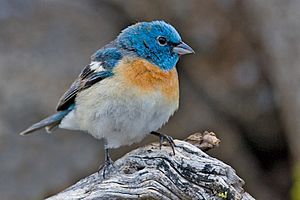Lazuli bunting facts for kids
Quick facts for kids Lazuli bunting |
|
|---|---|
 |
|
| Conservation status | |
| Scientific classification | |
| Genus: |
Passerina
|
| Species: |
amoena
|
 |
|
The lazuli bunting (Passerina amoena) is a small, colorful North American songbird. It gets its name from the gemstone lapis lazuli, which is known for its beautiful blue color.
Contents
What Does a Lazuli Bunting Look Like?
Male lazuli buntings are easy to spot. They have bright blue heads and backs. This blue is a bit lighter than their close relative, the indigo bunting. They also have clear white stripes on their wings. Their chest is a light rusty color, and their belly is white.
These birds might remind you of eastern or western bluebirds. However, lazuli buntings are smaller, only about 13 to 15 centimeters (5 to 5.9 inches) long. Their white wing stripes and short, cone-shaped beak also help tell them apart.
Female lazuli buntings are mostly brown. They are grayer on top and have warmer colors underneath. You can tell them apart from female indigo buntings by two thin, pale stripes on their wings.
The Lazuli Bunting's Song
The song of the lazuli bunting is a high, fast, and strong warble. It sounds similar to the indigo bunting's song. However, the lazuli bunting's song is usually longer and repeats less often.
Where Do Lazuli Buntings Live?
Lazuli buntings mostly breed in the western parts of North America. Their breeding range stretches from southern Canada down to northern Texas, central New Mexico and Arizona, and southern California. Along the Pacific coast, they breed as far south as northwestern Baja California.
When winter comes, these birds migrate south. They travel to southeastern Arizona and Mexico. They like to live in brushy areas and sometimes in weedy fields. They prefer places with good water sources and can even be found in towns.
What Do Lazuli Buntings Eat?
These birds mainly eat seeds and insects. You might see them looking for food on the ground or in bushes. However, males that are singing often hide high up in treetops, making them hard to spot.
Reproduction and Life Cycle
Lazuli buntings build a loose, cup-shaped nest. They make their nests from grasses and small roots. They usually place these nests in a bush. Females lay three or four pale blue eggs.
In the eastern and southern parts of their range, lazuli buntings sometimes breed with indigo buntings. This means they can have babies together, even though they are different species.
Measurements
- Length: 13–15 cm (5.1–5.9 in)
- Weight: 13–18 g (0.5–0.6 oz)
- Wingspan: 22 cm (8.7 in)
Images for kids
See also
 In Spanish: Colorín aliblanco para niños
In Spanish: Colorín aliblanco para niños




